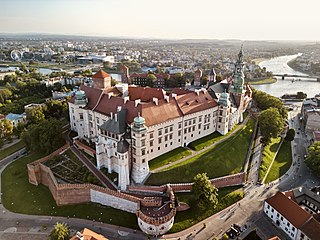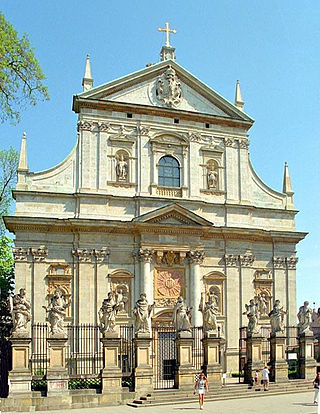
Lesko is a town in south-eastern Poland with a population of 5,755 (02.06.2009). situated in the Bieszczady mountains. It is located in the heartland of the Doły (Pits), and its average altitude is 390 metres above sea level, although there are some hills located within the confines of the city. Since 2002 it has been the capital of Lesko County.

The Royal Castle in Warsaw is a state museum and a national historical monument, which formerly served as the official royal residence of several Polish monarchs. The personal offices of the king and the administrative offices of the royal court were located in the Castle from the 16th century until the final partition of Poland in 1795. Situated in the Castle Square, at the entrance to the Old Town, the Royal Castle holds a significant collection of Polish and European art.

The Wawel Royal Castle and the Wawel Hill on which it sits constitute the most historically and culturally significant site in Poland. A fortified residency on the Vistula River in Kraków, it was established on the orders of King Casimir III the Great and enlarged over the centuries into a number of structures around an Italian-styled courtyard. It represents nearly all European architectural styles of the Medieval, Renaissance and Baroque periods.

Bartolomeo Berrecci was an Italian Renaissance architect who spent most of his career in Poland.

Neoclassical architecture in Poland was centered on Warsaw under the reign of Stanisław August Poniatowski, while the modern concept of a single capital city was to some extent inapplicable in the decentralized Polish–Lithuanian Commonwealth. Classicism came to Poland in the 18th century as the result of French infiltrations into the Polish millieu. The best-known architects and artists who worked in Poland were Dominik Merlini, Jan Chrystian Kamsetzer, Szymon Bogumił Zug, Stanisław Zawadzki, Efraim Szreger, Antonio Corazzi, Jakub Kubicki, Hilary Szpilowski, Christian Piotr Aigner, Wawrzyniec Gucewicz, Bonifacy Witkowski and Danish Bertel Thorvaldsen.

Giovanni Battista Trevano was an architect, builder, and servant of Sigismund III Vasa, one of the most eminent Baroque artists active in the Polish–Lithuanian Commonwealth in the first half of the 17th century

The Roman Catholic Metropolitan Archdiocese of Vilnius is an ecclesiastical territory or diocese of the Roman Catholic Church in Lithuania. Established as the Diocese of Vilnius in the 14th century, it was elevated to the rank of a metropolitan archdiocese by Pope Pius XI on October 28, 1925. It has two suffragan sees of Kaišiadorys and Panevėžys.

Bodzentyn is a town in Kielce County, Świętokrzyskie Voivodeship, in south-central Poland, with 2,168 inhabitants as of December 2021. Bodzentyn belongs to Lesser Poland. The town lies in the Świętokrzyskie Mountains, here main office of the Świętokrzyski National Park is located.

The Kraków Voivodeship was a voivodeship (province) in the Kingdom of Poland from the 14th century to the partition of Poland in 1795. Located in the southwestern corner of the country, it was part of the Lesser Poland region and the Lesser Poland Province.

Tarczek is a village in the administrative district of Gmina Pawłów, within Starachowice County, Świętokrzyskie Voivodeship, in south-central Poland. It lies approximately 8 kilometres (5 mi) west of Pawłów, 13 km (8 mi) south of Starachowice, and 28 km (17 mi) east of the regional capital Kielce.

The architecture of Poland includes modern and historical monuments of architectural and historical importance.

The Palace of the Kraków Bishops in Kielce, was built in the 17th century as a summer residence of bishops of Kraków in Kielce, Poland. The architecture of the palace constitutes a unique mélange of Polish and Italian traditions and reflects political ambitions of its founder. Currently the palace houses a branch of the National Museum with an important gallery of Polish paintings.

Ogrodzieniec Castle is a ruined medieval castle in Podzamcze, near Ogrodzieniec, the south-central region of Poland called Polish Jura. Originating in the 14th century the castle was rebuilt several times in its long history. It is situated on the top of 515.5-metre-high Castle Mountain, the highest hill of the Kraków-Częstochowa Upland. The ruins are open to visitors and are a part of Trail of the Eagles' Nests, a hiking trail that connects a number of well known castles in the region.
The Dunajec river castles is a chain of thirteen medieval castles, built in southern Lesser Poland, along the Dunajec river. The castles protected the border between the Kingdom of Poland and the Kingdom of Hungary, as well as a very important international trade route, which went along the Dunajec and the Poprad all the way down to the Danube river. Most of the castles are in ruins now, and some have disappeared. Their history dates back to the period known as the Fragmentation of Poland in the early 12th century, when, according to his will, known as the Testament of Bolesław III Wrymouth, the country was divided into several provinces. The Dunajec river castles were located on the territory of two castellanies, Wojnicz and Nowy Sącz, in the extreme south of the Seniorate Province.

Bolków Castle is a castle located in Bolków on the Castle Hill, with a 396 metres, where the hillside is cut by the Nysa Szalona river, with a sharp precipice ; the eastern side of the hill gradually lowers, taken up by the town. The castle is an upland stronghold, covering an area of 7600 m2. The castle is located in Bolków, Lower Silesian Voivodeship; in Poland.

Castle of Bishops in Siewierz - a castle formally housing castellans who raised the castle in the thirteenth century. The stronghold formerly fortified a hamlet in the area, which can be traced back to the origins of the Church of St. John the Baptist; now located close to the National Road No. 78 - for rapid travel to Katowice. The names of the first castellans were Jaks and Wawrzyniec. The castle is located in Siewierz, Silesian Voivodeship in Poland.

The Basilica Cathedral of St. Mary of the Assumption is a large Gothic building situated in the Polish city of Włocławek located near to the Vistula River. Construction on the cathedral began in the 1340s, and it was consecrated in 1411. It was still under construction in the 15th and at the beginning of the 16th century, until its completion in 1526. It is one of the greatest treasure troves of funerary art in Poland next to the cathedrals in Gniezno, Poznań and Kraków.

Tadeusz Mikołaj Thullie was the last Royal Secretary of King Stanisław August Poniatowski. He was ennobled in 1767, receiving the Prawdzic coat of arms. He was the son of Adam Thullie, lieutenant general of the Polish army, and Katarzyna née Fontana, a sister of royal architect Jakub Fontana.

Korzkiew Castle is a fourteenth-century Romanesque castle located in Korzkiew, Lesser Poland Voivodeship in Poland. The castle is part of the Trail of the Eagles' Nests tourist route. The castle complex includes the castle ruins, housing residence, a grange and park, enlisted on the register of objects of cultural heritage of the Lesser Poland Voivodeship.
The Polish Inquisition was an ecclesiastical institution established in the 13th century to combat heretics. Permanent structures of the inquisition in Polish territories were established in the first half of the 14th century and always played a subordinate role to episcopal tribunals, which were already combating heretics in Poland in the mid-13th century. The final end of the existence of inquisitorial tribunals came with the Reformation and the victory of the idea of religious tolerance in Poland in the second half of the 16th century.




















